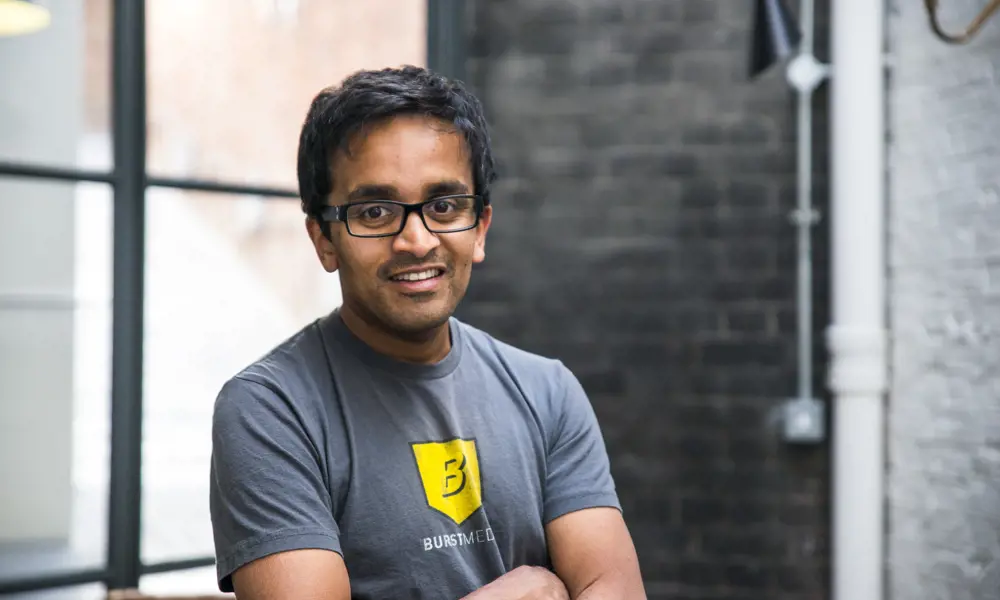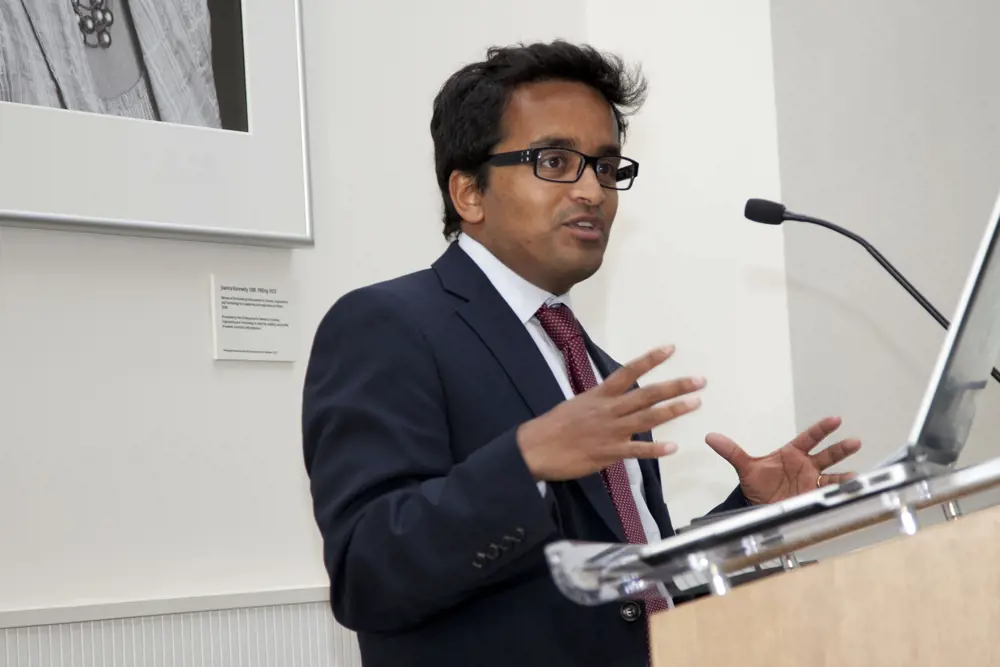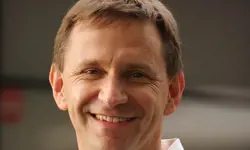
Natural born code writer
Success in starting Blinkx, a software business turned media company, has garnered Suranga Chandratillake FREng superstar status in the world of IT, not to mention a Royal Academy of Engineering Silver Medal. But the coverage fails to mention that he was the first web editor of the University of Cambridge’s student newspaper, Varsity. Chandratillake was studying computer science, so the Varsity team asked him to sort out its fledgling web presence. This was an early introduction to a new technology that was about to disrupt the media and the wider world, and would pave the way for businesses such as Blinkx, itself a media revolutionary.
The digital life
Chandratillake is a part of what has come to be known as the ‘digital native’ generation, someone who has always had computers in their lives. In his case, it started at around the age of eight when his father, an academic scientist at the University of Manchester, brought home a BBC Micro computer. Like many youngsters, Chandratillake wanted to play computer games. “I asked my dad if he would buy me a game,” he says. OK, said his dad, but first you have to learn how to program the computer. Chandratillake got side-tracked into writing software, which he was fascinated by. He was, he says, “fluent in BASIC [programming language] in less than two weeks. I never got a game because I didn’t need one after I had learned how to program. It was much more fun to write programs for myself. I enjoyed computers and software, writing code pretty obsessively really from the age of eight or nine. This meant that when I was thinking about university I thought that computer science looked really interesting.” He chose to study the subject at the University of Cambridge partly because he found it relatively easy, leaving time to pursue other interests, such as economics and politics.
I enjoyed computers and software, writing code pretty obsessively really from the age of eight or nine. This meant that when I was thinking about university I thought that computer science looked really interesting
When it came to finding a job after graduation, Chandratillake learned another lesson in economics. This was the time of the dotcom meltdown, and his first job ended after just a few months. Fortunately, one Cambridge company, Autonomy, was still hiring and Chandratillake joined it as the lead R&D engineer on Autonomy’s core data analysis engine. It was not long before the company sent Chandratillake to California as Chief Technology Officer to set up an office in Silicon Valley.
Autonomy was in the business of managing huge amounts of data with its enterprise customers, but the Bay Area enthusiasm for consumer technology rubbed off on Chandratillake. He found himself in a world of quick moving startups, with investors rushing to Silicon Valley to back the businesses that they hoped would one day be worth billions of dollars. The chance to enter the realm of consumer tech came when Chandratillake started an internal project in Autonomy. Partly to deal with the floods of emails that he faced in his job, Chandratillake set up a small team to develop software that would index and find information at a desktop level.
The move out of enterprise and on to the desktop, with what was to become the Blinkx software, was a big shift for Autonomy. “The Blinkx product and customer base were completely different from Autonomy,” he explains. This prompted Autonomy to set up Blinkx as a standalone business in 2005, with Chandratillake as CEO. Hoping to turn it into one of those billion dollar businesses, it followed the traditional funding model, with additional help from Autonomy, to get the business started.
As a small standalone venture, Blinkx could change direction quickly. Within a year, the company switched focus from finding emails and text files to searching the hundreds of thousands of hours of video and audio files uploaded to the internet. In effect, Blinkx became an internet search engine for audio and video content, evoking frenzied media comparisons with Google. That was just the first change of direction. In the end, Blinkx decided to exploit its ability to search multimedia files to sell advertising. Blinkx became a media company, and Chandratillake found himself again using the web for media purposes. As he says, changing direction is a standard pattern in Silicon Valley with Oracle, Microsoft and Facebook reinventing themselves over the years. “All great tech companies do.”
changing direction is a standard pattern in Silicon Valley with Oracle, Microsoft and Facebook reinventing themselves over the years. “All great tech companies do.”
This change of direction was an important lesson that he continues to draw on and it added to Chandratillake’s entrepreneurial experience, which began while he was working at Autonomy with Mike Lynch, the company’s CEO. “I was lucky to have joined Autonomy, which was an incredibly entrepreneurial place,” he explains.
Blinkx also taught Chandratillake how to manage, and raise money to fund, a rapidly growing business. In 2007, that growth led to a float on the London Stock Exchange, where in time Blinkx joined the small club of IT startups in the UK worth over a billion dollars.
Making changes
Chandratillake’s time as CEO of Blinkx also convinced him that he preferred engineering and technology to running a large business. He also wanted to spend more time with his family and his young son, and missed being around for important meetings on the future of the business’s technology and new products. As he said after the event “instead of thinking about the future of video online, I was worrying about legal, HR and investor issues.”
In 2012, Chandratillake moved aside from the CEO’s job to become Chief Strategy Officer (CSO). He made the shift, he said, “so that I could really focus on what I’m most passionate about at Blinkx – innovation, ideas and implementation of what I believe to be the future of video online”. Chandratillake admits that he had to convince people that the choice to change jobs was his. As he explained after the move, “people assume no one would voluntarily step back from running their own company.” He stayed on as CSO for a few more years, dispelling any lingering doubts about his reasons for moving offices.
I could really focus on what I’m most passionate about at Blinkx – innovation, ideas and implementation of what I believe to be the future of video online
His family also came into play when Chandratillake started to think about his next move. He and his wife, who works in the biotech sector, had a tentative plan to return to Europe with their two children. They had also spent time in the UK after Chandratillake finally stepped down from Blinkx. He sensed that things were changing in Europe, especially in the UK. If anything, he says, the stakes are higher here. “In Silicon Valley it almost doesn’t matter if the company you’re in succeeds or not, because there is another one five minutes later, whereas here it felt more important. That drove us back as well.”
Chandratillake did not rush into a new job. After the Blinkx float, he spent a couple of years trying to work out what he wanted to do. In the end, he opted for another of his earlier passions: finance. “Finance is fascinating to me,” he says. “I had done a fair amount of personal investing, so I had a sense of what that was like. I knew that I enjoyed it and the way that it gave me exposure to early-stage companies.” He liked the idea of being able to work with a spread of companies and being able to share some of the things that he had learnt. He wanted to help fledgling CEOs to navigate the obstacles that he had experienced in his business.
Tech investor
Chandratillake decided to become an investor with a focus on technology. He made the move after he got to know the team at Balderton, a relatively small finance firm that specialises in investing in startups, often in technology. Chandratillake is one of five partners who own Balderton. The firm, set up in 2000, has funds totalling $2.3 billion and is involved in what is known in the business as series-A funding. This typically means investing between $5 and $6 million dollars to back teams of 30 to 40 people. As well as providing finance, the firm also draws on the experiences of its own team to guide founders through what can be difficult times. Chandratillake may not have had a business fail under him, sometimes seen as a badge of honour, but he says that it was not always a roaring a success. “At Blinkx, we had a lot of products and businesses that didn’t work. At Balderton, we put a premium on having a team that has had entrepreneurial experience because the entrepreneurs we back are going to go through some really rough times.”
As the resident engineer, Chandratillake believes that it is also important to have a team that includes people who understand technology. This knowledge of technology, he says, sets Balderton apart from other funds, many of which, as he puts it, have always been investors and can struggle with the technology.

At Balderton, Chandratillake is keen to mentor and support the young entrepreneurs whose businesses the firm is investing in © Rachel Swindenbank
Chandratillake is careful when it comes to deciding what constitutes ‘technology’, feeling that a ‘tech’ label cannot just be put on a business idea just because there is a computer somewhere in the system. For example, he explains: “I have looked at companies in the wine business, where you just go to a website, search for what wine you would like to buy, buy it, and they have got a warehouse and send it to you. There’s nothing wrong with the business but I don’t see how that’s a technology business.” However, Balderton has backed a ‘wine business’ that really does depend on technology. Vivino uses the processing power and connectivity of smartphones to bring together customers and wine suppliers. The smartphone app recognises wine labels and wine lists, for example in a restaurant, and matches the image using visual intelligence. It can tap into the views of fellow drinkers as well as wine suppliers and can track down suppliers of a wine that takes your fancy. “Before, you would have to roll out machines everywhere, and have a website that people have to come to,” says Chandratillake. “Now you don’t have to do any of that; you can put everything onto a mobile phone, which was impossible five years ago.”
Vivino is one of a growing portfolio of tech investments that Chandratillake has a hand in. On the engineering front, he highlights several in additive manufacturing. For example, Sketchfab allows people to share 3D designs over the internet: “A bit like how YouTube lets you upload a video and share it anywhere you want, you can upload your 3D design and share it anywhere you want.” Another additive manufacturing business is 3D Hubs: “You can go on to its site, upload any 3D designs you have, and 3D Hubs will find you a local 3D printer who can print it for you.”
If Chandratillake likes an idea, and if he can persuade the business to take his money, a deal can happen in as little as two weeks
It takes time to find interesting investment opportunities such as these. Chandratillake estimates that the firm sees around 4,000 ideas from entrepreneurs from across Europe each year. They can be direct approaches, a business that someone in the firm finds interesting, or occasional tips from ‘angels’ who invest in the early stages of a company. Of these leads, each partner may look at as many as 200 business ideas. If Chandratillake likes an idea, and if he can persuade the business to take his money, a deal can happen in as little as two weeks.

In his role as a mentor in the Royal Academy of Engineering’s Enterprise Hub, Chandratillake is heavily involved in the Academy’s support of startup businesses, judging competitions and giving talks to aspiring engineering and technology entrepreneurs
Thinking like an engineer
Chandratillake sees his role as being more than simply finding and funding good ideas. He is there to help the founders to realise their ambitions. This is where the knowledge of what it takes to develop a business and its technology, and his background in starting a successful business and navigating it through sticky times, comes into play.
Chandratillake provides this mentoring beyond Balderton’s own portfolio. As a member of the Enterprise Committee at the Royal Academy of Engineering, he can often be found in the recently opened Enterprise Hub, rubbing shoulders with the young engineers who have grand plans for new businesses. “The Hub has got billions of dollars’ worth of investors signed up as supporters. It has a large number of mentors, both from the Fellowship and from outside.” He has also been involved in judging competitions at the Academy for startup businesses. “All of these things are helping engineers who want to build businesses.”
Chandratillake believes passionately in the power of the engineering way of thinking. “If you follow an engineering discipline, it gives you a way of thinking about the world and of modelling and structuring your thoughts.” His view is that an engineering education, and the mathematical skills it involves, sets you up to do just about all that it takes to start and grow a business. For example, he insists, “anyone who has done an engineering degree can do the maths involved in marketing”.
If you follow an engineering discipline, it gives you a way of thinking about the world and of modelling and structuring your thoughts
Chandratillake dismisses the mindset that engineers cannot take a business through to success. “There is a very strong notion in the UK that starters and founders are almost never the right person to build a company. I really hate that idea,” which he dubs the “boffin fallacy”. There is no equivalent word for the word boffin in America, he adds, “but every Brit knows what a boffin is. It is this slightly incompetent, doesn’t understand the real world, scruffy character, who understands some minute bit of technology.” In reality, he insists, technology moves so rapidly, and is such a dynamic market, that the ‘non-boffin’ skills an entrepreneur needs to learn are trivial compared to being able to understand the technology at the heart of what they are building. Just look at the big tech successes, he continues. “Facebook has reinvented itself at least three times because the guy at the heart of it all is a technical guy.”
Chandratillake now wants to convince young engineers that they can succeed as innovators and entrepreneurs. Fortunately, he sees signs of progress in the UK. A lot has changed since he left for Silicon Valley at the beginning of the century. When he completed his degree it was, he says, rare for graduates to think about starting a business: they were split roughly evenly between staying in academia, getting a job with ‘big IT’ or going into the City. “Now it is totally different,” he adds. “Last year the single biggest recruiter out of the University of Cambridge’s computer lab was Entrepreneur First.” This accelerator, he explains, lets engineers and computer scientists try being an entrepreneur for six months before they get their first job. “The fact that that has come out of nowhere in about 15 to 20 years has been remarkable.”
Chandratillake now wants to convince young engineers that they can succeed as innovators and entrepreneurs
Career timeline and distinctions
Born, 1977. Studied Computer Science at the University of Cambridge, 1997–2000. Lead R&D engineer, Autonomy, 2001. Chief Technology Officer, Autonomy, 2003–2005. Founder and CEO, Blinkx, 2005–2012. Young Global Leader, World Economic Forum, 2009–present. Chief Strategy Officer, Blinkx, 2012–2014. Awarded Royal Academy of Engineering Silver Medal, 2012. Fellow of the Royal Academy of Engineering, 2013. Royal Academy of Engineering Enterprise Committee, 2013–2017. General Partner, Balderton Capital, 2014–present. Board member, Vivino, 2014–present. Board member, Magic Pony Technology, 2015–present.
There is now more practical help for young entrepreneurs, he says. “If you started a company 20 years ago in Britain, there were not that many people around who could actually help you think about how to grow it into a billion-dollar enterprise. I think that is getting better all the time, and that is one of the reasons why I moved back.”
However, there are still barriers to innovation in the UK. For a start, he says, we need to do a better job of convincing engineers that they can do it themselves, and that they can actually build companies if they want to do that. They should then be supported in their ability to do that.
Another obstacle can be finance for new businesses. There may be plenty of angels in the UK who can provide seed funds to help engineers start businesses, but it can be harder to raise the seven-figure sums that Balderton and a handful of other finance houses can put into a business. In part, he says, this is because local angels, for example in places like Cambridge, one of the UK’s IT hotspots, struggle to get venture capitalists excited enough to nurture startups through to the next stage. It works better in Silicon Valley, he adds. “There are people who invest really early, as little as $5,000 to get something off the ground, but then they are very good at handing that on.”
We love things that go public because that typically means that they are going to stick around for longer and make more impact on society in general, which is definitely part of what we like to see
How will Chandratillake judge his success in this new phase of his career? As an investor, he naturally wants to make money, but that is only a part of the plan. He wants to make a real difference. This is one reason why he is enthusiastic about his work with the Academy and why he is keen to back businesses that can float on the stock exchange. “We love things that go public because that typically means that they are going to stick around for longer and make more impact on society in general, which is definitely part of what we like to see.” This is partly why he returned to the UK. “I look at Europe and I think that there are going to be a number of really tough challenges economically over the next 20 or 30 years. Britain will not be shielded from that. One of the things that I think can help us is getting good technology, and exploiting the fact that we are already very good at technology.”
***
This article has been adapted from "Natural born code writer", which originally appeared in the print edition of Ingenia 72 (September 2017).
Contributors
Michael Kenward OBE
Author
Keep up-to-date with Ingenia for free
SubscribeRelated content
Software & computer science

Compact atomic clocks
Over the last five decades, the passage of time has been defined by room-sized atomic clocks that are now stable to one second in 100 million years. Experts from the Time and Frequency Group and the past president of the Institute of Physics describe a new generation of miniature atomic clocks that promise the next revolution in timekeeping.

The rise and rise of GPUs
The technology used to bring 3D video games to the personal computer and to the mobile phone is to take on more computing duties. How have UK companies such as ARM and ImaginationTechnologies contributed to the movement?

EU clarifies the European parameters of data protection
The European Union’s General Data Protection Regulation, due for adoption this year, is intended to harmonise data protection laws across the EU. What are the engineering implications and legal ramifications of the new regulatory regime?

Evolving the internet
He may have given the world the technology that speeded up the internet, but in his next move, Professor Nick McKeown FREng plans to replace those networks he helped create.
Other content from Ingenia
Quick read

- Environment & sustainability
- Opinion
A young engineer’s perspective on the good, the bad and the ugly of COP27

- Environment & sustainability
- Issue 95
How do we pay for net zero technologies?
Quick read

- Transport
- Mechanical
- How I got here
Electrifying trains and STEMAZING outreach

- Civil & structural
- Environment & sustainability
- Issue 95